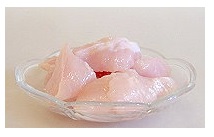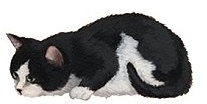

We will discuss the feeding of adult cats in this article. Feeding kittens is discussed elsewhere.
Any recommendations on serving sizes we can make can only be a good guess – a starting point to use in your play with your cat’s portion sizes and mealtime frequency Determining your cat’s ideal daily portion size is unfortunately not as easy as a chart which tells you: if your cat weighs this much, feed her that amount.
Cats are individuals. Some are big, but thin. Others are small, but fat. They are young and old, male and female, active or sedate, and more. Some have fast metabolism and others don’t.
Any chance of providing you with a simple chart is made more difficult by the fact, that a homemade diet will turn out differently with the meat you use and with how precisely you follow instructions. Some customers use lean poultry, other use fatty beef. A fatty beef diet will be more filling and calorie dense than the same volume of a lean turkey diet. Some customers add more water, giving the food more volume but not more calories, while others omit water and wonder why their cats gain weight on so little food. Caregivers are often distressed about their cat’s behavior of finishing their plate in less than a minute, asking for more food, pestering them at the fridge, or taking food stuff off counters or out of the trash, prompting them to think that their cat is starving or lacking something! Some cats don’t do this, but most will not miss an opportunity to eat. It is natural for an animal to be opportunistic, and this is part of their instinct to survive. However, much of this is conditioning: how your cat was raised and how your cat has trained you!
 Food requirement should be based entirely on body condition, and not on behavior. If your cat suddenly looses weight without changes in the diet, consult with your Veterinarian about possible illness or internal parasites.
Food requirement should be based entirely on body condition, and not on behavior. If your cat suddenly looses weight without changes in the diet, consult with your Veterinarian about possible illness or internal parasites.
It is especially difficult to monitor food intake and its effects on a cat allowed outdoors. Outdoors, your cat can regurgitate food without you knowing, and all you notice is that he or she is loosing weight. The eating of mice and other prey will add calories, but also predispose your cat to intestinal parasites. Outdoor, cats will often travel long distances, which takes extra calories. Outdoor, cats may scavenge food from neighbors, which puts them at a great risk not only from weight gain.
Our suggestions is to feed a daily portion of 130 g – 175 g as two or three meals every day.
* If you have a dainty female cat, start by feeding 60 g in the morning and the same in the evening
* If you have a robust male cat, feed 75 g in the morning and the same in the evening
Unless you have a very large cat, like a young, active, outdoor, male Main Coon cat, or a crazy Siamese, 99% of cats will fall into this portion range. Some older, more sedate cats will actually gain weight on that amount of food a day.
Here are some more factors to consider:
- Cats will digest food better, and get more out of it, when given small portions 3-4 times a day. Cats
will also pester you less for food, if you divide their daily portion into more frequent meals - Most cats will not digest a portions size of 120 g cup well, and will likely suffer from a degree of
indigestion. Many cats will actually regurgitate food if you feed a portion larger than 60 g. Ability to
eat a large meal in one sitting decreases with age. Occurrence of regurgitation is more frequently
observed in middle aged to older cats - Young cats often behave especially frantic to get their paws on food. They may climb up on you
while you are preparing or serving their food, climb right into the fridge when it is being opened,
and come running at any sound of activity in the kitchen. Young cats, but not exclusively so,
may steal food left out on counter tops, sometimes even take off with a loaf of bread - Cats are individuals. Some will maintain a level of excitement about food throughout their live.
Others are largely uninterested in eating, and need coaxing to eat even as kittens. Most cats do
well eating three meals every day, but some are not interested in eating more often than twice
every day; sometimes they only show enthusiasm for one meal per day. Other cats will eat anything,
any time, for no reason. Cats’ personality and emotional state is very much expressed by how
they eat! - Cats’ appetite and attitude towards food does not only hinge on a certain personality type, but
also on early kittenhood conditioning. Competition from other kittens, type of food fed, and frequency
of food fed will all affect what kind of relationship cats will have with food later in life - Cats’ behavior towards food and eating is also influenced by how well they have trained you. Do
you respond to their begging by feeding them something when you have a meal yourself, work in
the kitchen, or open the fridge? A rewarded behavior will be repeated. Although your intention may
not have been to reward your cats for that behavior, you did nonetheless yield to their pressure
![]()
If you find a begging cat intolerable, start conditioning your cat early and consistently by feeding him or her at a quite, designated place – preferably not in your kitchen or dining room, so your cat does not form a strong food association with these areas. If you feed your adult cat three times daily (like morning, evening,
and just before bed) as much as he or she needs to maintain body weight, and refrain from giving food out of the fridge or from the table, your cat should settle into a routine that is comfortable and predictable for both of you. Feed treats away from areas where you prepare and eat your own food, and keep groceries and the trash out of your cat’s reach. If your cat is allowed into the kitchen and on counter tops, this means you must keep food stored away and inaccessible. If your cat is successful in snatching food off the counters, he or she will continue to check these areas out for food. After all, they are not stupid and will not resist instinct simply to be a good kitty for you.
Cats of the genus Felis, including the domestic cat, are adapted to prey on rodents, small birds, and the occasional reptile and amphibian as the main staple of their natural diet. A single mouse weighs no more then 30 gram, providing approximately 60 kcal. In order to meet their daily caloric requirement, cats must eat an average of five prey animals every day. This amount of food is not consumed all as one meal, but as separate meals throughout the day as the cats succeed in catching that prey. Field observations have concluded that most small cat species are adapted to and prefer to be active during dusk and dawn – the time when they will hunt most of their prey – resulting in an intake of several smaller “meals” during these hours. Naturally, cats will rest, groom, doze, or sleep during daytime hours.
While we can draw some practical insight from the natural model, feeding five meals of 30 gram each to our cats during the morning and evening hours is hardy a possible solution for most of us. Our personal experience has been that cats do very well eating two meals every day of 50 g – 70 g each.
Weighing your cat’s serving is a good tool, because we have a natural tendency to over-feed Regurgitation of food can be almost entirely abolished by feeding meal sizes not exceeding 35 g, and to feed the daily requirement as 3-4 meals. Young, large, active cats who require more than 140 g of food every day should be given an extra meal rather then increasing the size of their meal.
The stomach of a cat is about the size of a walnut when empty. It can stretch, but trying to fit a 115 g of food into it as one meal, is “over-stretching” it a bit. Saliva and digestive juices will add additional volume. If the cat does not bring the food back up, proper digestion will be difficult. A cat will not always select instinctively what he or she needs and how much. We have conducted experiments with our cats, offering them as much food as they want, and most of them will eat until overcome with an urge to purge. Only some – those raised without siblings and competition for food – will eat until full and leave the rest behind.
We hope this information is helpful, although we can not give you a precise formula or chart to follow. One lesson, which keeps repeating itself to us, is: cats are individuals. While we can give you guidelines, none of our suggestions will work for everyone.
Cats are a joy and a challenge all in one. They are a challenge especially when feeding them. So specialized in what they would naturally eat, caregivers have a very narrow margin of error of what cats thrive on or die from. One thing is certain, though: if you invite a carnivore into your life that eats meat, it is not going to be cheap! Unfortunately, you don’t get the deal of good AND cheap when feeding cats.


 Deutsch
Deutsch
